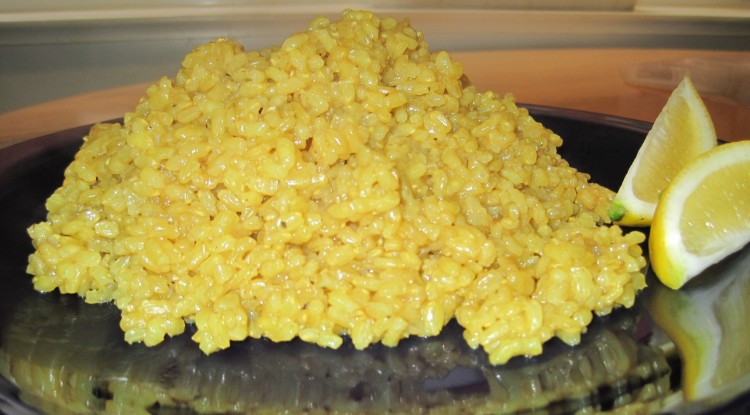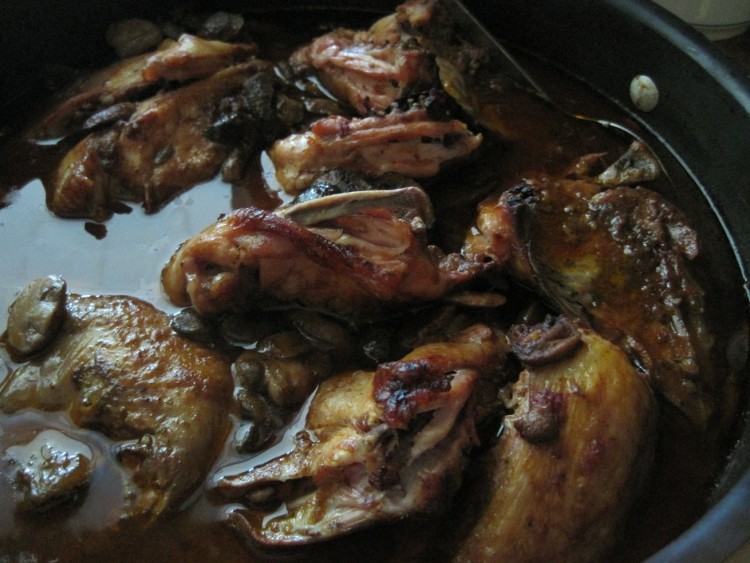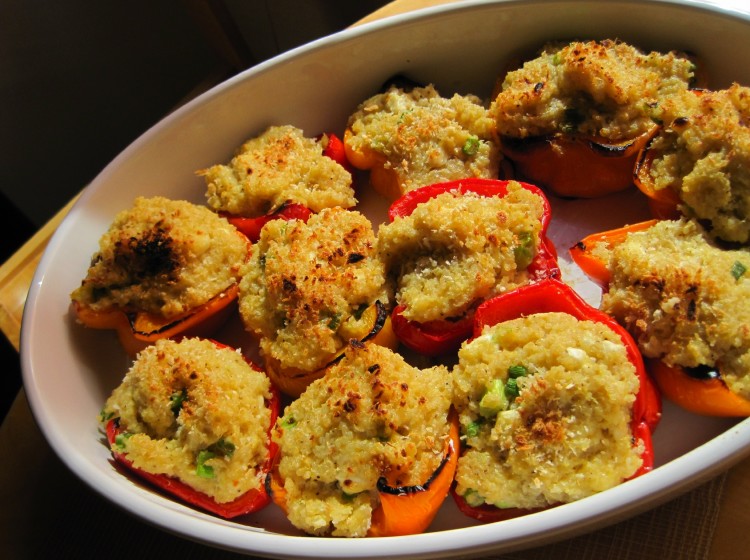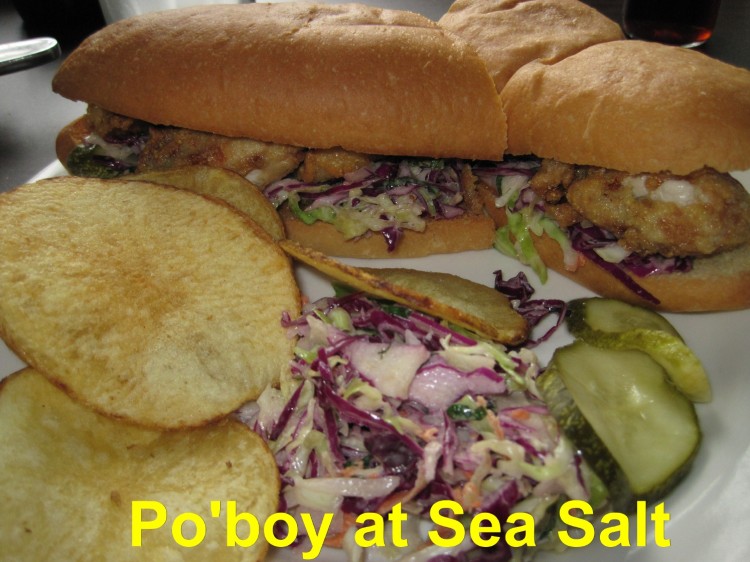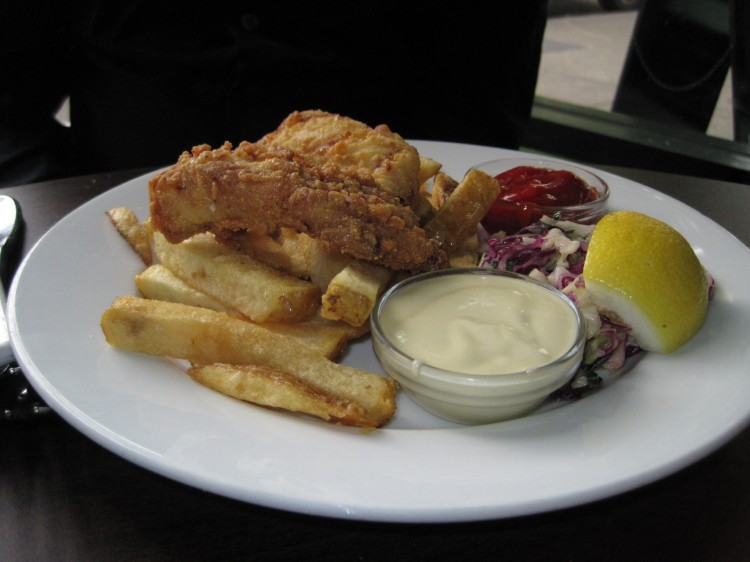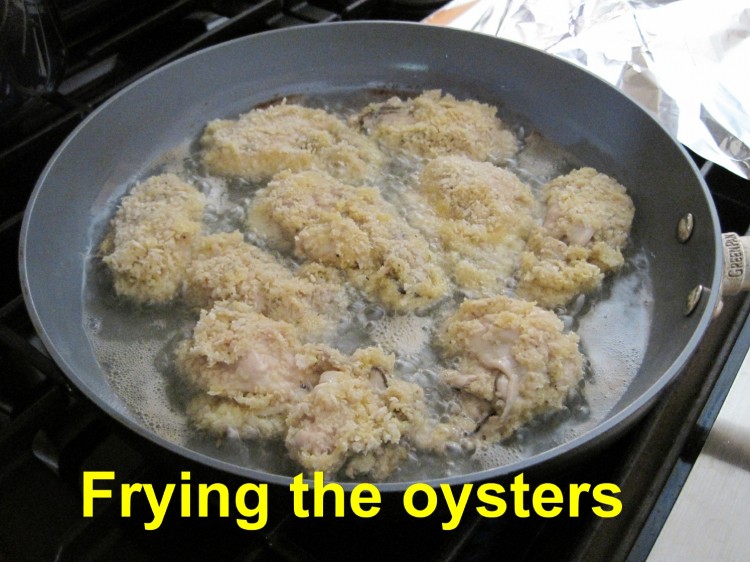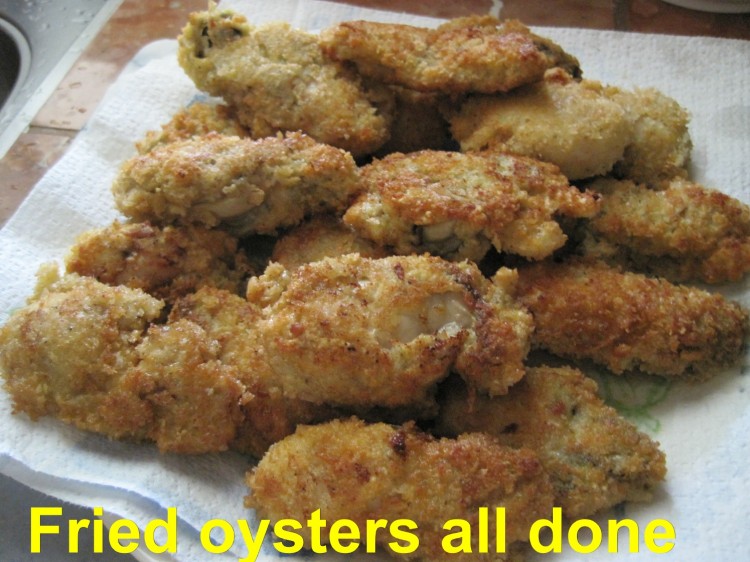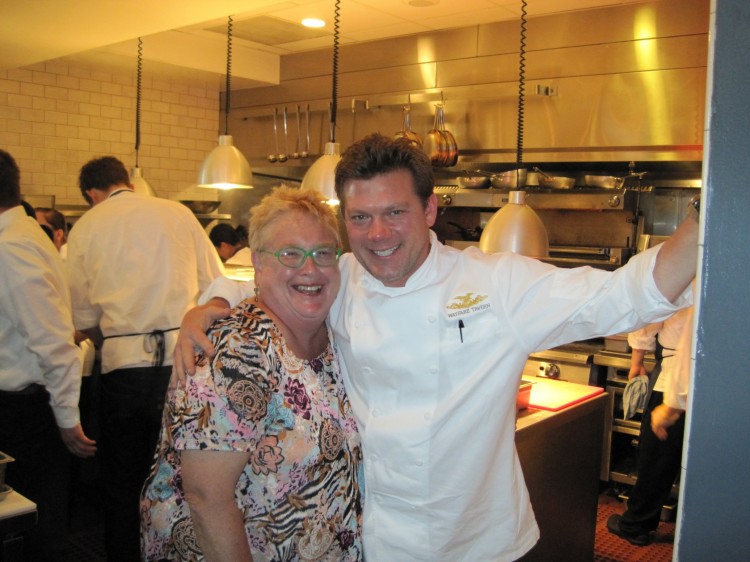
Wayfare Tavern
558 Sacramento Street
San Francisco, CA
(415) 772-9060
Click on link above for current hours
SF Bay Area food writer and personality (to say the least), GraceAnn Walden, asked me to dine with her at Tyler Florence’s new restaurant, Wayfare Tavern, as part of a public relations meal. While Wayfare Tavern had been getting some good press during its flagship first month, GraceAnn is so outrageous that you’re guaranteed a good time regardless, so of course I accepted. Once GraceAnn’s review is published, I’ll link to it here.
With celebrity-chef owned places there’s always that “hype versus substance” factor. And there is significant hype surrounding Food Network icon Tyler Florence, whose easy-on-the-eye countenance seems to be everywhere these days. Seriously, he’s got one foot firmly planted in Rachael and Martha territory – and I’m not just talking about pots and pans at Macy’s. There’s even a Tyler Forence iPhone app now.
Now, just because he’s cute and a TV star and selling a whole bunch of stuff doesn’t mean he has no chops. This one-man megalopoly is a culinary graduate of Johnson & Wales, and worked his way up by sweating it out on the line for years down South and in New York City before being “discovered.”
I bring all this up because the adoring public tends to lash out at people it makes famous.
The idea that celebrity chefs aren’t “real” has been kicking around for years. Most of them are – even if they haven’t been spending much time in the kitchen. This is true of all chefs-on-the-rise: the more responsibility they take on, the less time they have to stand in front of a stove. No reason to apply a higher standard to Tyler Florence.
For me, it boils down to motivation and commitment. Heart, if you will. If a restaurant is opened solely to make a quick buck with no respect for local culinary traditions, and Mr. Big is never in situ unless he’s there to sell autographed cookbooks, I’d rather they both stay out of San Francisco.
I was pleased beyond measure that Wayfare Tavern has gravitas and did not disappoint.
If you didn’t know Tyler Florence owned the place before walking in, I don’t think you’d be able to tell, given how schtick-free it is in that regard. I’m not surprised. This is the first of three restaurants the chef is planning to open in the San Francisco Bay Area, which he now calls home. It’s clear he wanted to do right by The City.
What we have here is a turn-of-the-century San Francisco tavern-themed restaurant that’s all all dark wood, stuffed wildlife and fireplace. I half expected A. P. Giannini to pop in for a dozen oysters after a hard day at the Bank of Italy. Giannini may be long gone, but suited bankers from Bank of America and other money houses around the corner on Montgomery Street occupy bar stools on weeknights, so he’s well represented.
The bar was busy. Aproned bartenders call out greetings to regulars as they enter the restaurant, reminding me of the old, dark wood, man cave-type establishements I used to visit when I worked on Wall Street in New York City. As the evening progressed, a mixed crowd of lovely people filled the first floor to capacity.
We were seated on the first floor directly in front of the fireplace and perpendicular to the open kitchen. Goodies were flying out of the kitchen – including Chef Florence, who greeted GraceAnn with a big smile and a hug.
Let me get this out of the way here and now: Tyler Florence was friendly, accommodating and good-humored throughout the evening, regardless of how often he was pestered.
He’s clearly invested here – passionate about the ingredients he’s working with and his dishes.
Wayfare Tavern’s one, all-day, menu is in keeping with its theme, so there are plenty of old school options. Entrees like hangtown fry nod to San Francisco’s past, with Southern influences from the chef-owner’s roots popping up in offerings like fried chicken and banana pudding. If you’re looking for evidence that this is a modern-day California restaurant, you’ll find it in the long list of creative appetizers, and there are indications throughout the menu of a commitment to ethical food practices.
If you’re not able to find an entree that pleases you, you can have a burger and fries.
Service at table was top-notch. Our server was skilled, competent, friendly and fun. We had a very small table, so finely-tuned orchestration added to our enjoyment of the evening. The hosts were polite, if a little selective in who they were really nice to, so it soothed my ever-so-slightly ruffled feathers to be treated so well by all other staff.
First things first, let me rave about the popovers they serve in place of bread. They’re what an Acme sour baguette is to Wonder bread. I think this is the best popover I ever had, and I’ve had many. Craggy, crisp, golden-brown and substantive with a moist, egg batter-webbed interior.
We started with a dozen assorted oysters (market price), which were outstanding in terms of freshness and flavor. The Fanny Bay were subtle, with that slight cucumber finish, and the Barron Point were sweet and creamy. The oyster tray smelled like the sea as it sat virtually under my nose on our small table. Mignonette and cocktail sauces provided.
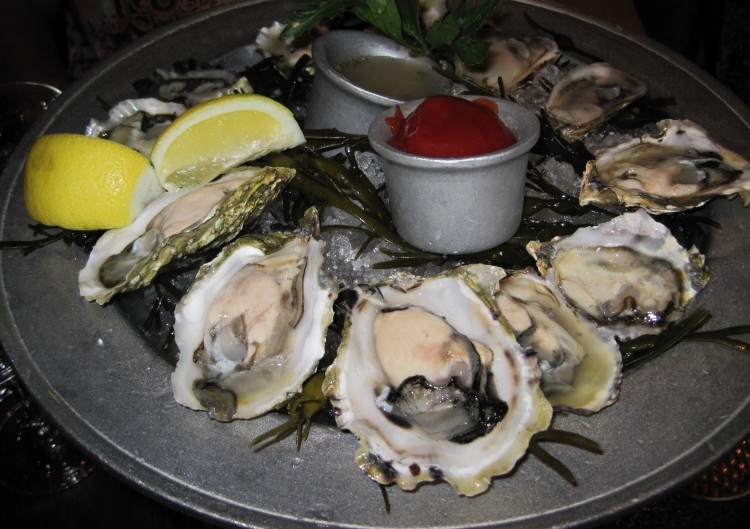
Our parade of appetizers started with the deviled eggs ($9 for 6 halves), which were creamy, soft and mild. Comforting, as deviled eggs should be, but we agreed the kitchen is too timid with the mustard for our liking.
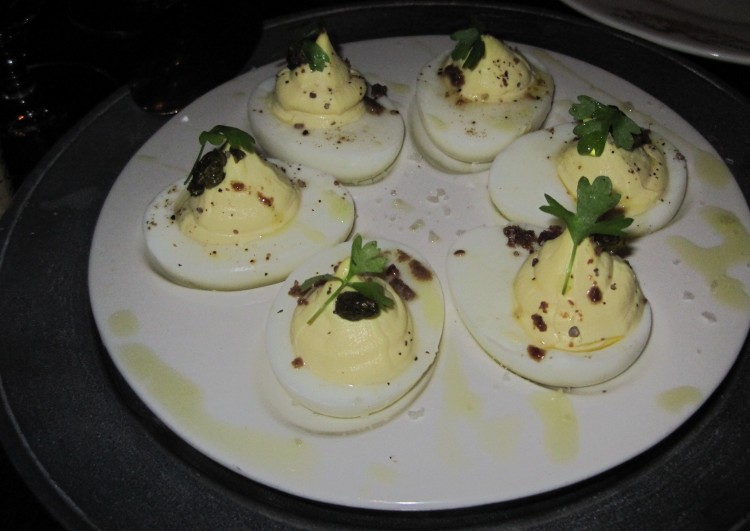
I was thrilled to see steak tartare on the menu – and I suppose the nerve to put this on an SF Bay Area menu is part of the same nerve responsible for the taxidermy. Wayfare’s version is made from grass-fed, corn-finished beef fillet and served with a raw, organic egg yolk on top. This is the first time I had grass-fed beef as tartare, and I was surprised at the mild flavor. The texture was a bit mushy, though – as if the fillet had been overpulsed in a food processor. The generous half-portion was $16, and you’d spend more than that to make it at home. If you’re scared of tartare, this would be a good place to try it.
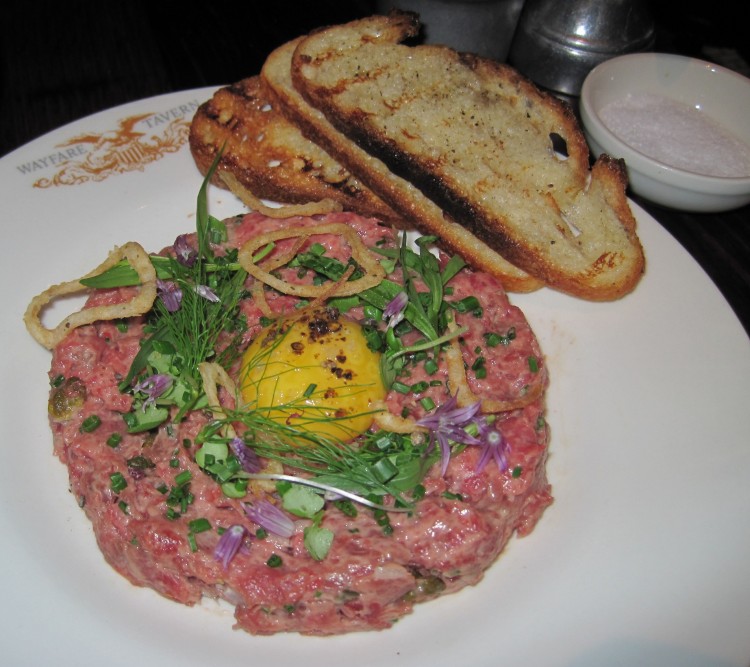
The Monterey Bay sardines ($14) were plump and tasty, with a bright garlic-lemon sauce.
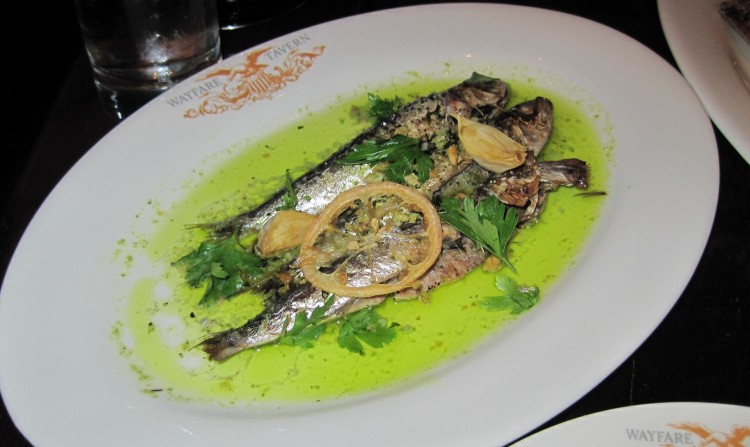
I’m glad the salt roasted bone marrow ($14) was split in two, because it made sharing this luscious dish easy. Molasses crostini came on the side – a master stroke. The molasses added bittersweet, chocolate-coffee notes that worked well with the marrow. I would have liked more than two crostini on the plate, though.
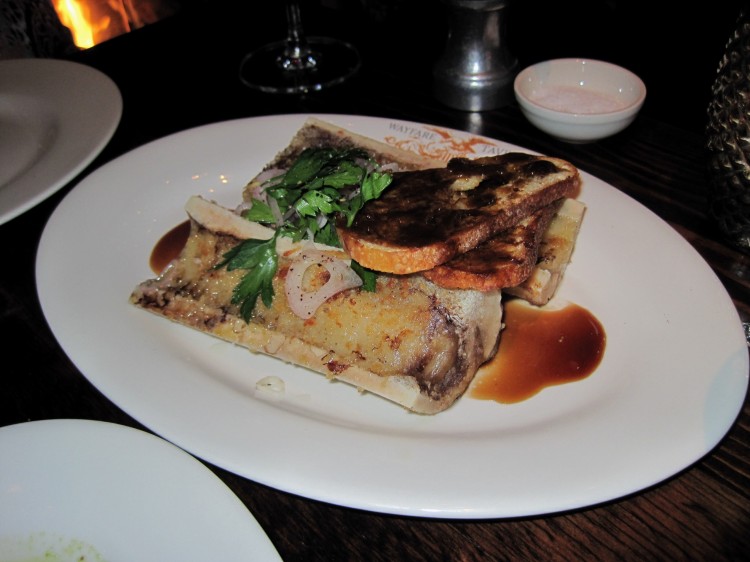
The hangtown fry ($18) included a wonderfully light omelet and perfectly cooked bacon – but the oysters were a disappointment. Traditionally, oysters in a hangtown fry are partially cooked and then folded into the omelet. This is a deconstructed fry, as most of them are these days, with bacon strips and fried oysters served atop a plain omelet. Hangtown fry lives and dies by oysters, and these were significantly overcooked and limp, and their breading lacked flavor.
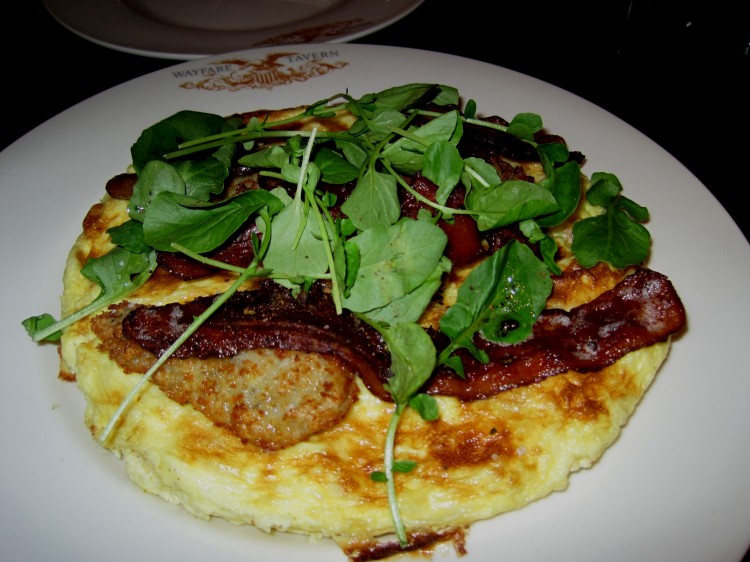
There was robust, meaty flavor in the Wayfare Burger “Le Grand” ($18), made from a “proprietary grind” of four cuts of grass-fed, corn-finished beef – including short rib and ribeye. Cowgirl Creamery’s Mt. Tam cheese, bacon and roasted onion enhanced the whole affair. Normally I’m against all those burger add-ons when there’s really good meat, but they all worked fine, as did the homemade brioche bun. The accompanying fries – fried in peanut oil – were good.
Organic fried chicken ($22), one of Tyler Florence’s signature dishes, was moist and flavorful from the buttermilk brine. Served mostly boneless and with lemon wedges for squeezing, it could have been more crispy.
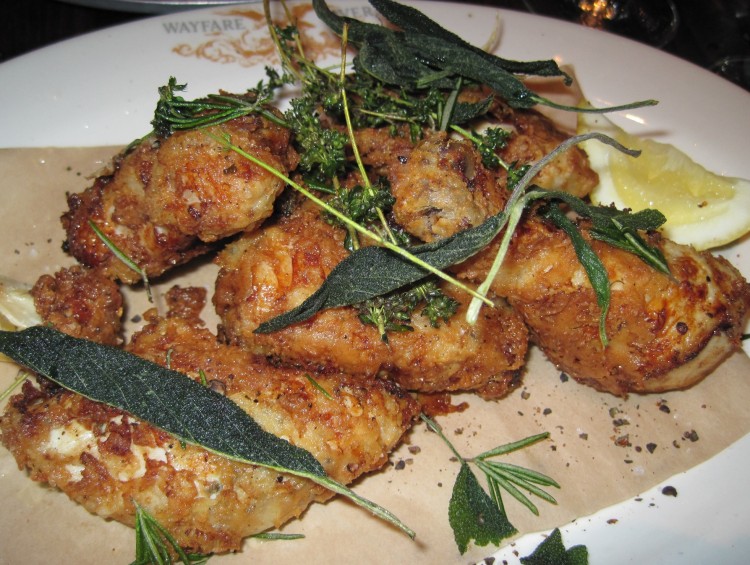
The side of creamed corn ($8) was excellent. Whole kernal corn cut from the cob arrived in a light, flavorful cream sauce with smoked olive oil and chive blossom.
Although full, there was no way I was leaving without trying the house-made salted caramel ice cream. It’s quite salty, and normally paired with the pineapple upside-down cake ($8). I was too full for the cake, so I just had the ice cream, which I enjoyed thoroughly.
GraceAnn had the banana pudding, which is Tyler Florence’s father’s recipe. I didn’t taste it, since I’m not a custard kind of girl, but GraceAnn was pleased – though you’ll have to read her review for the skinny.
After the meal I wandered over to BART in the evening air. While crossing over California Street toward Market, a woman crossing in the other direction looked over and said, “You look happy tonight!”
Indeed, and not just because I drank half a bottle of 2008 Tyler Florence Split Rock Vineyard Pinot Noir ($115). Actually, I had more than half. I love a nicely-balanced Pinot!
